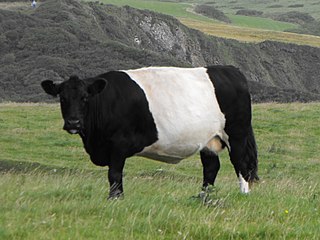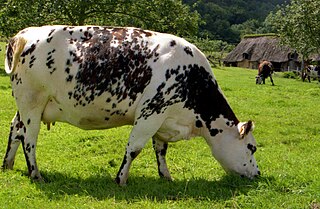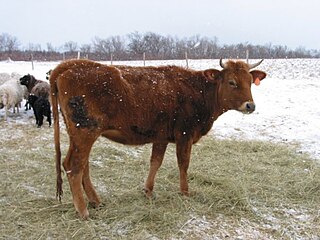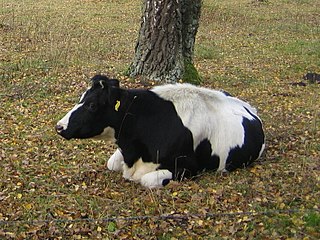
The Lakenvelder is a Dutch and German breed of dairy cattle. It is reported from the Netherlands and Belgium, but may be extinct in Germany.

The Guernsey is a breed of dairy cattle from the island of Guernsey in the Channel Islands. It is fawn or red and white in colour, and is hardy and docile. Its milk is rich in flavour, high in fat and protein, and has a golden-yellow tinge due to its high β-carotene content. The Guernsey is one of three Channel Island cattle breeds; the other two are the Alderney, which is now extinct, and the Jersey.

The Dairy Shorthorn is a British breed of dairy cattle. It derives from the Shorthorn cattle of Teesside, in the North Riding of Yorkshire and in Northumbria in north-eastern England. The Shorthorn was for this reason at first known as the Durham or Teeswater.

The Brown Swiss or American Brown Swiss is an American breed of dairy cattle. It derives from the traditional triple-purpose Braunvieh of the Alpine region of Europe, but has diverged substantially from it. It was selectively bred for dairy qualities only, and its draft and beef capabilities were lost. Milk yield was measured in 2013 at 10231 kg (22600 lb) per year; the milk has about 4% butterfat and 3.5% protein and is suitable for making cheese.

The Belted Galloway is a traditional Scottish breed of beef cattle. It derives from the Galloway stock of the Galloway region of south-western Scotland, and was established as a separate breed in 1921. It is adapted to living on the poor upland pastures and windswept moorlands of the region. The exact origin of the breed is unclear, although the white belt for which they are named, and which distinguishes the breed from black Galloway cattle, is often surmised to be the result of cross-breeding with the similarly coloured Dutch Lakenvelder.

The Abondance is a French breed of dairy cattle. It originated in the high valleys of Haute-Savoie and shares its name with the commune and valley of Abondance and the former canton of Abondance in that region. Its area of origin lies within the former Chablais province of the Duchy of Savoy, and until the late nineteenth century it was for that reason known as the Chablaisienne.

The Gir or Gyr is an Indian breed of zebuine cattle. It originated in the Kathiawar peninsula in the state of Gujarat, and the name of the breed derives from that of the Gir Hills in that region. Other names include Bhodah, Desan, Gujarati, Kathiawari, Sorthi and Surti.

The Aubrac or Laguiole is a French breed of beef cattle. It originates on the Plateau de l'Aubrac in the Massif Central in central southern France, from which it also takes its name. It has a wheat-coloured coat and dark hooves, switch, muzzle and eyes.

The Normande is a breed of dairy cattle from the Normandy region of north-west France. It is raised principally for its milk, which is high in fat and suitable for making butter and cheese, but also for its meat, which is marbled and good-flavoured. It is a world breed: it has been exported to many countries and is present on all continents.
The Agerolese is a breed of dairy cattle from the area of Agerola, in Campania in southern Italy. It is particularly associated with the Sorrento Peninsula and Monti Lattari. It derives from cross-breeding of indigenous Podolica cattle with Italian Holstein-Friesian, Bruna Italiana and Jersey cattle. It is one of the sixteen minor Italian cattle breeds of limited diffusion recognised and protected by the Ministero delle Politiche Agricole Alimentari e Forestali, the Italian ministry of agriculture.

Canadienne cattle, also known as Black Canadienne, French Canadienne, and Black Jersey, are the only breed of dairy cattle developed in Canada. They originated in the 16th century, when French settlers brought cattle over for foundation stock to settle Canada. The Canadienne were the most common breed of domestic cattle in Canada until the late 19th century, when other breeds began to displace them. Today, the Hereford and Holstein have become the most common types of cattle in Canada. The Canadienne, though still found on farms and ranches across the nation, is now comparatively rare except in certain areas of the province of Quebec. Efforts by an active breed society and the Quebec government have been made in recent years to preserve the breed from extinction.

The Froment du Léon is an endangered French breed of dairy cattle from the coastal region of northern Brittany, in the north-west of France. It is named for the historic Viscounty of Léon, in the départements of Côtes-d'Armor and Finistère in the extreme north-west of Brittany. It is valued for the quality of its milk, which is yellow and high in fat, and is particularly suitable for making into butter.

The Ringamålako is an endangered Swedish breed of dairy cattle. It is named for the village of Ringamåla in the southern Swedish county of Blekinge, and is found primarily in southern Sweden. It is similar to the type of Swedish Red-and-White cattle of the 1940s, and is considered a valuable genetic resource.

The Norwegian Red or Norsk Rødt Fe is a Norwegian breed of dairy cattle. It was formed in 1961 through successive mergers of various traditional and regional breeds. In 2016 it accounted for approximately 85% of the cattle in the country, and about 99% of the national dairy herd.

The Fjäll is a traditional Swedish breed of polled mountain cattle. It was threatened with extinction in the 1970s and 1980s, but recovered after a breed association was formed in 1995, partly thanks to stocks of frozen semen. Microsatellite analysis has shown it to be closely related to the endangered Bohuskulla breed.
The Lucerna is a Colombian breed of dual-purpose cattle. It is a composite breed, created in the twentieth century by cross-breeding local Criollo cattle of the Hartón breed with imported dairy cattle of European type. This was the earliest composite breed to be developed in South America.

Yakutian cattle, Саха ынаҕа in the Sakha language, are a cattle landrace bred north of the Arctic Circle in the Republic of Sakha. They are noted for their extreme hardiness and tolerance towards freezing temperatures.

The Väneko is an endangered Swedish breed of dairy cattle. It is named for the village of Väne-Ryr in the landskap of Västergötland, in western Sweden. It is a traditional domestic Swedish breed, and derives from a group of cattle discovered in the 1990s, at a time when all traditional Swedish horned cattle were thought to have disappeared.

The Swedish Friesian, Swedish: 'Svensk Låglandsboskap', often abbreviated to SLB, is a Swedish breed of dairy cattle. It was established in about 1870 from imports of cattle of Dutch Friesian or German Black Pied type. From about 1970 it has been systematically cross-bred with the American Holstein-Friesian breed, to the point that the original Swedish type may be extinct. The name Swedish Holstein may also be used.It is a type of Swedish cattle breed.

The Dutch Belted or Dutch Belt is an American breed of dairy cattle. It derives from the Lakenvelder of Germany and the Netherlands, of which examples were imported to the United States from 1838. It became an important dairy breed in the early twentieth century, but could not compete with the Holstein-Friesian. By 1970 it was close to extinction; from 1993 the American Livestock Breeds Conservancy was active in the recovery of the breed. In 2021 it was listed as "critical" on the watchlist of the conservancy.



















